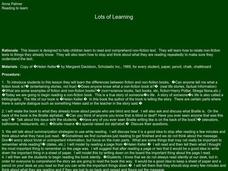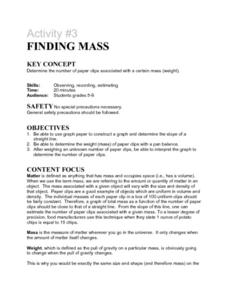Curated OER
Blending Bunnies
Students use the short /a/ sound to blend letters and form words. They use enlarged copies of bunnies with different letters written on them. They combine the "bunnies" to spell words with the short /a/ sound, and then read the words...
Curated OER
Reading to Learn
Children learn to read and comprehend non-fiction text and explore how to relate non-fiction texts to things they already know. They then examine how to stop and think about what they are reading repeatedly to make sure they understand...
Curated OER
Champions of /Ch/
Students identify the digraph /ch/ in written and spoken language. Students practice identifying initial and final placement of the digraph /ch/ in words by identifying pictures containing the sound. They decode and spell words in with...
Curated OER
Christmas Around the World (Grade 2)
Student groups create slides on one of the cultures listed. They view videos that show United States families celebrating Christmas based on their native countries' traditions and a video which tells the story of La Bafana, the old woman...
Curated OER
Have a Backone
Students create a visual organizer that describes different groups of vertebrates in this pre-writing activity. They view and discuss a video on descriptive writing and then form small groups to research vertebrate classes using the...
Curated OER
Acids, Copper, and Zinc
Students observe chemical reactions using post-1982 pennies. They observe the reaction of an acid with zinc but not copper under the same conditions over a two week period.
Curated OER
Activity #7 Mass, Volume and Density
Students comprehend that density depends on the type of material and not on the amount of material. They use a spoonfl of table salt and a box of table salt and have the same density. Pupils comprehend that density is calculated by...
Curated OER
Activity #3 Finding Mass
Students use graph paper to construct a graph and determine the slope of a straight line. They determine the weight (mass) of paper clips with a pan balance. Pupils weigh an unknown number of paper clips, and to interpret the graph to...
Curated OER
How Does a Liquid Become a Solid?
Students explore the energy changes from a liquid to a solid. They model the arrangement of a solid and the change in states due to changes in energy using desks and chairs. Assessment questions are provided in lesson plan.
Curated OER
Activity #15 What Happens To A Liquid As Energy Is Added?
Young scholars model the arrangement of particles in a liquid. They use the model, to demonstrate how a gas is formed from a liquid with no increase in temperature as energy is added. Pupils model the arrangement and movement of gas...
Curated OER
Activity #6 How Fast Do Reactions Go?
Students name the factors (concentration, temperature, and a catalyst) which can affect the rate of a chemical reaction. They use their knowledge of particle theory to explain their observations. Pupils comprehend that the...
Curated OER
Activity #7 Apple Color Change
Students compare the different rates of reaction between an apple covered with vitamin C and an apple with no vitamin C. They compare the different rates of reaction between an apple placed in the sun and one not exposed to the sun. ...
Curated OER
Activity #5 Environmental Effects
Students explain the implications of particle theory of The Law of Conservation of Matter for problems of pollution and waste disposal. They describe, in terms of atoms and molecules, what happens to materials when they are dissolved or...
Curated OER
Activity #17 Co2 From Alka Seltzer
Students observe what occurs when Alka Seltzer tablets are added to water. They explain why water stays in the jar when it is above the surface of the water. Pupils test for the presence of carbon dioxide by conduting the match test.
Curated OER
Genes: The Building Blocks of Life
Students examine various topics on genetics. Students explore the Internet to gather information on genetic testing, genetically engineered food, forensics, DNA and cloning. They research and determine the best way to fund each of the...
Curated OER
Shhhh...Something Is Fishy!
Students study the consonant digraph /sh/. They listen to tongue twisters containing the /sh/ digraph and write words beginning with /sh/. They create words using Elkonin boxes that have the /sh/ digraph.
Curated OER
Fantastic Facts
Fourth graders are introduced to expository texts. They dwell to formulate the comprehension and gain the main ideas. Students encounter explicit comprehension strategies to help them transition into this new type of text.
Curated OER
Physical Science: Bubble Prints
Students participate in a lab experiment involving soap bubbles and making bubble prints. They blow bubbles into the soap and add paint to make bubble prints. With extra time, they can play with a variety of bubble toys to see what...
Curated OER
Introducing Angles
Sixth graders identify, compare and interpret the characteristics of polygons and angles in order to meet spatial sense, geometry and measurement standards. They also sort shapes into three categories, polygons (regular and irregular)...
Curated OER
Introduction to Slope Fields
Students plot slope fields. In this introduction to slope fields lesson, students plot 12 slope fields for given differential equations.
Curated OER
Focus Questions: Amelia Earhart
In this history worksheet, students do research and find information about Amelia Earhart. Students answer 18 questions about her biographical overview, the world flight and disappearance and the search. No information is given on the...
Curated OER
Easter Internet Research
In this Easter Internet research worksheet, students answer 15 questions about the observance of Easter. No web sites are suggested; students do their own research.
Curated OER
State and National Parks
In this insects worksheet, students 7 questions regarding state and national parks. A print out version of this worksheet is available, but the online version contains links to various webpages with information on the topics, so...
Curated OER
The Westing Game: Chapters 1-4
In The Westing Game chapter questions activity, students complete a series of short answer questions over chapters one through four to advance their understanding of the text.























